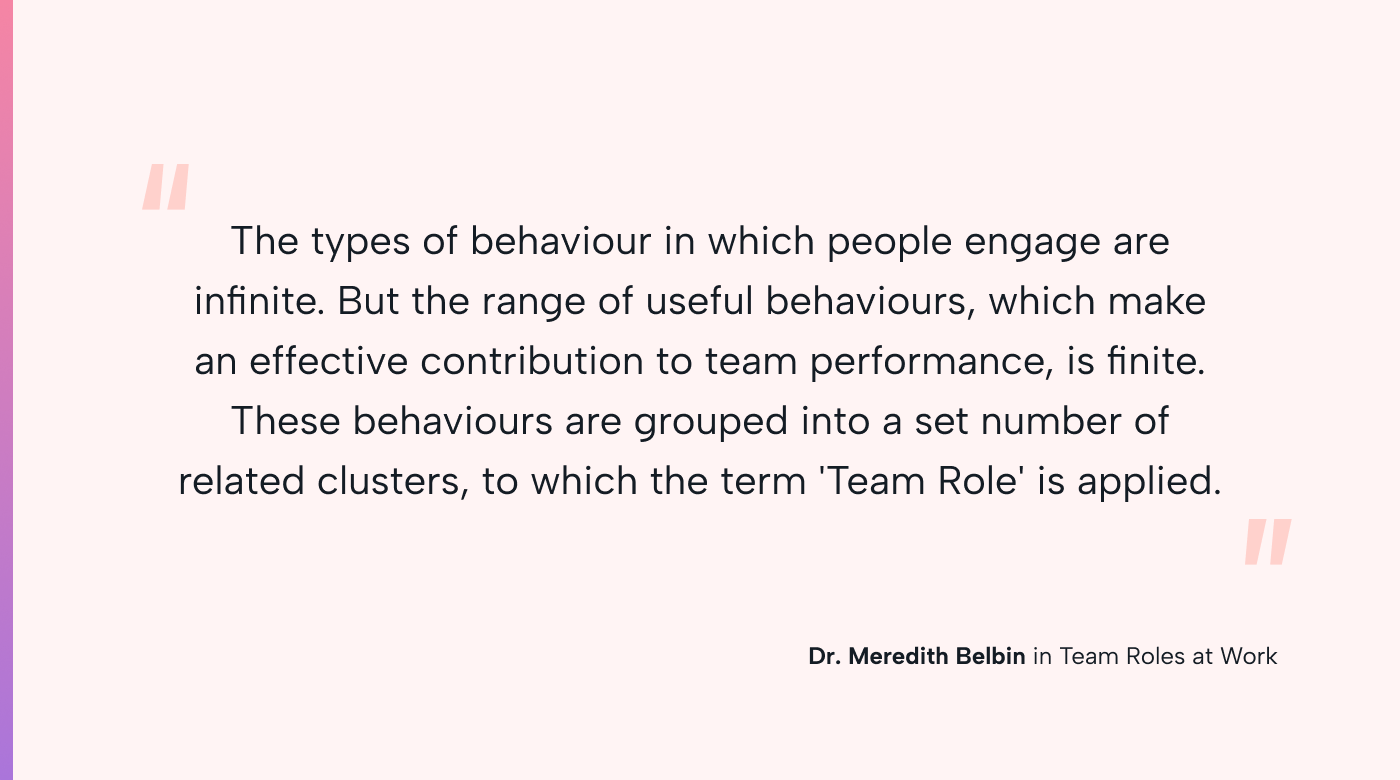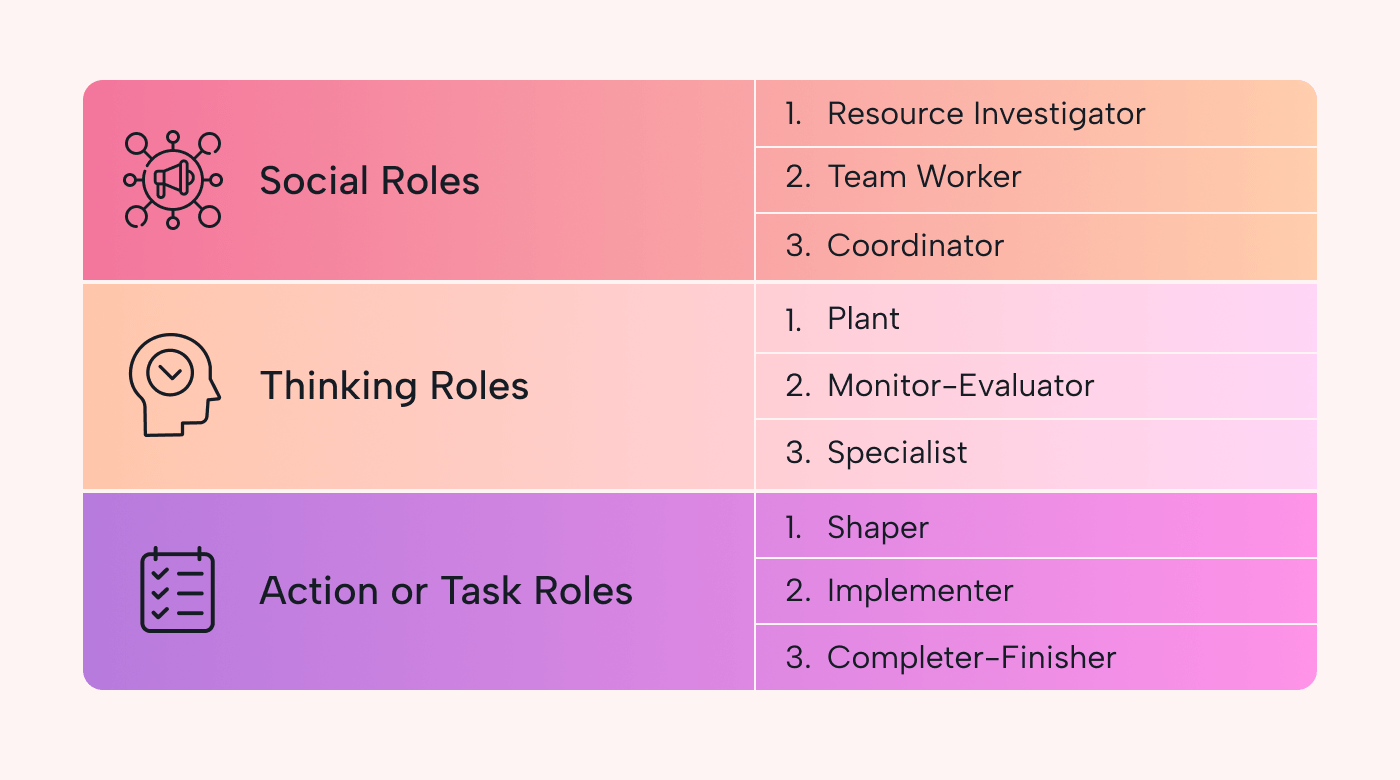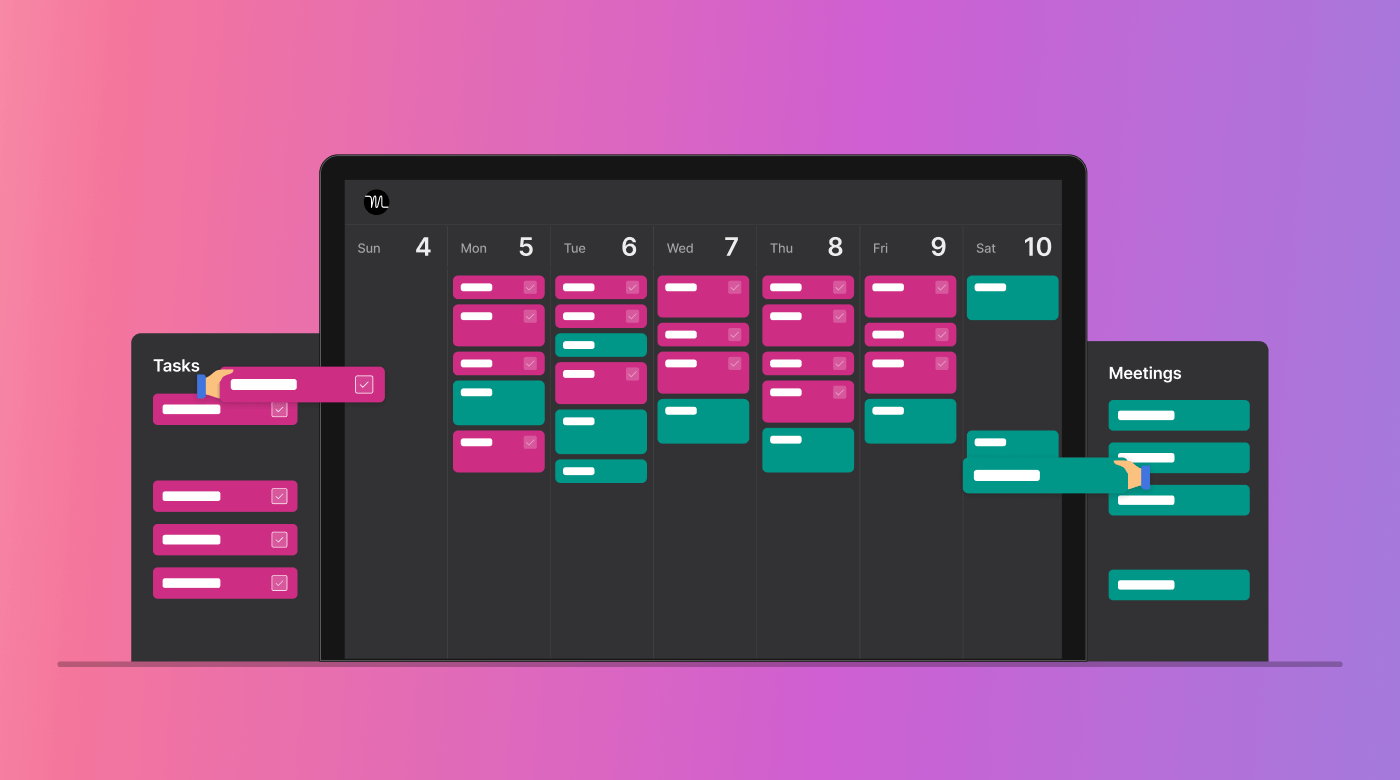Team leaders know that it can be challenging to build a cohesive, balanced team.
Sometimes, it seems as if your team members don’t understand your way of thinking — or each other’s — just as you may have some trouble understanding theirs.
Personality type differences come into play, but problematic team functioning can also be due to misunderstanding team roles. Some of these roles can be perplexing since they’re different from your own. However, if you’re managing a team, understanding team dynamics is vital to your success.
This article focuses on Belbin Team Roles, a model of nine distinct roles that team members tend to take on. Understanding and working with these roles will be of great benefit to both yourself and your team.
What are team roles?
Team roles are part of a larger field of study called team dynamics.
By “team dynamics,” social scientists refer to the interactions and relationships between members within a group. This includes how individuals communicate, collaborate, and contribute to achieving common goals.
Understanding team dynamics and work styles helps identify the strengths, weaknesses, and roles within a team. This, in turn, leads to more efficient problem-solving, more creativity, and greater overall effectiveness.
 |
Most importantly, a team that works well together is likely to be more engaged. That’s critical since 41% of employees believe that engagement or a supportive culture would make their company a better place to work.
Why are roles important in a team?
Despite people having a wide range of different personalities, when they come together in a team, they tend to take on certain roles to complete the work.
For instance, one person might always initiate projects or conversations, another might be labeled the “big thinker” who contributes the 30,000-foot perspective, and a third might be called on to work out the details in a project plan.
The roles in a team are like pieces in a puzzle; they fit together to create a complete picture. When you identify and define them, you lay the foundation for efficiency and collaboration.
The clarity that comes from each team member knowing their specific part helps avoid confusion and overlap.
Acknowledging distinct roles encourages individual strengths to shine while promoting a sense of unity and purpose. It’s a strategic way to ensure that every person’s talents are used to the fullest. When that happens, your team can achieve its goals with harmony and precision.
Where does the Belbin Team Roles model come from?
Belbin Team Roles is a model that identifies nine different roles individuals might take on within a team. It was developed by Dr. Meredith Belbin in the late 1970s.
Meredith Belbin was born in England in 1926 and spent much of his professional life there, working at the intersection of management theory, psychology, and organizational behavior.
Belbin’s interest in team dynamics began while he was working at Henley Management College’s Industrial Training Research Unit (ITRU). Through observing teams, administering personality tests, and conducting detailed interviews, Belbin and his research team discovered that successful teams had a balanced mix of individuals playing different roles.
These observations led to the formulation of the Belbin Team Roles theory.
 |
Belbin’s initial research started in 1969, and he published his findings in 1981 in a book titled Management Teams: Why They Succeed or Fail. His book and Team Role theory have since become central to many team-building efforts in organizations around the world.
The model is used to help teams function more effectively by determining — and then leveraging — the strengths of individual team members.
What are the 9 Belbin Team Roles?
Belbin identified three groups based on three core differences in the team roles people tend to play: social roles, thinking roles, and action or task roles.
Within each of these categories, Belbin identified three subcategories of people with different but related characteristics — leading to nine distinct roles.
Below are the nine Belbin Team Roles, with a brief summary of each. For more details, visit the Belbin website.
 |
A. The social or people-focused roles
These roles are predominantly characterized by their social and communication skills. They include the following:
1. Resource Investigator
Characteristics: Resource Investigators are curious and outgoing. They explore new opportunities and bring fresh ideas to the team.
Strengths: Their enthusiasm and networking abilities help keep the team innovative and well-resourced.
Weaknesses: They may lose interest once the initial excitement wears off, leading to a lack of follow-through on promising leads.
2. Team Worker
Characteristics: Team Workers are the glue that holds the team together. They’re diplomatic and supportive, and they strive to maintain harmony in any group they’re a part of.
Strengths: Their ability to smooth over conflicts and foster positive relationships creates a cooperative environment that’s valued by the rest of the team.
Weaknesses: Sometimes, their focus on harmony hinders decisive action or allows poor performance to go unchallenged.
3. Coordinator
Characteristics: Coordinators excel at defining goals and delegating tasks. They facilitate teamwork and contribute skillfully to decision-making.
Strengths: Their leadership abilities strengthen collaboration and direct the team efficiently toward common goals.
Weaknesses: At times, they may be perceived as manipulative or over-controlling, which can negatively affect team morale.
B. The thinking or thought-focused roles
In this group, thinking and technical skills are dominant. The three subtypes are as follows:
1. Plant
Characteristics: Plants are the team’s creative thinkers. They generate unique ideas and provide innovative solutions to problems.
Strengths: Their creativity and unconventional thinking often lead to breakthroughs and fresh perspectives.
Weaknesses: Sometimes, their ideas are too radical or impractical, and they may struggle with details and execution.
2. Monitor-Evaluator
Characteristics: Monitor-Evaluators are the analytical minds of the team — the critical thinkers. They evaluate ideas objectively and see all sides of an issue.
Strengths: They use their ability to critically analyze situations to make sure that decisions are well-informed and free from bias.
 |
Weaknesses: They may be perceived as overly critical or unemotional, which can hinder their rapport with other team members.
3. Specialist
Characteristics: Specialists bring specific expertise and deep knowledge to the team. They’re committed to professional excellence in their fields.
Strengths: Their specialized skills are invaluable in situations that require technical or industry-specific knowledge.
Weaknesses: They may become overly focused on their own areas of expertise and get bored when other subjects are discussed, which can limit their contributions to broader team goals.
C. The action or task-focused roles
This group is characterized by an action-oriented, go-make-it-happen attitude, whether at the beginning or the end of a project cycle. The subtypes are as follows:
1. Shaper
Characteristics: Shapers are driven and passionate, and they thrive on challenges. They also tend to be natural leaders, often pushing the team toward goals and creating a sense of urgency.
Strengths: Their energy and determination inspire others. This can drive progress and help the team overcome obstacles.
Weaknesses: Sometimes, their aggressiveness leads to conflict, and they may overlook or ignore their teammates’ feelings and opinions.
2. Implementer
Characteristics: Implementers bring a systematic and efficient approach to the team. They turn ideas into action and follow through on plans.
Strengths: Their ability to organize and eye for detail ensure that tasks are completed accurately and in a timely manner.
Weaknesses: Their focus on structure may limit their own and the team’s creativity and flexibility, which can stand in the way of adequate responses to sudden changes.
3. Completer-Finisher
Characteristics: Completer-Finishers are the ones who dot all the “i’s” and cross all the “t’s.” They focus on finishing tasks to the highest standards they can muster.
Strengths: Their dedication to quality ensures that their work is done without errors, which adds tremendous value to the final product.
Weaknesses: They may become overly focused on minor details, which can lead to inefficiency and stress over deadlines.
How to determine your teammates’ preferred roles
While reading through the list above, you may have gotten an intuitive sense of which role or roles each of your team members plays and which one you yourself gravitate toward.
However, if you want to gain more clarity on your team’s composition, there are some great tools available on Belbin.com.
Your team members can find out their Belbin Team Role strengths and weaknesses by using the official Belbin Self-Perception Inventory online and receiving Belbin Individual Reports.
There’s a secondary recommended step: team members can ask for feedback from people they work with by using the Observer Assessment tool. This generates an updated individual report that shows how others see and value them.
Working with the Belbin Team Roles
Once your team members receive their reports, it’s extremely helpful to spend some quality meeting time comparing roles and objectively discussing how these differences affect the team’s culture and functioning — either for good or for ill.
Also, make an inventory of which roles are over- or underrepresented — and how the team can adjust so that all nine roles are represented. For instance, you could ask an Implementer to also take on the role of a Completer-Finisher if the latter role is absent in the team.
Challenging team members to experiment with different roles can help the team break out of fixed patterns and generate more mutual understanding and respect.
Belbin.com also offers custom workshops for teams that need a helping hand in how to make the various roles and personalities work harmoniously and productively together.
The benefits of knowing your teammates’ Belbin Team Role
There are both personal and team benefits to understanding the Belbin Team Roles. Here’s a quick look:
Personal gains
Understanding Belbin Team Roles unlocks the door to both personal growth and better team harmony.
 |
For instance, if you’re an Implementer, knowing your ability to turn ideas into actions allows you to take charge of execution.
If you’re a Team Worker, your knack for smoothing over conflicts becomes a vital asset in maintaining team unity.
This awareness isn’t just about identifying what you do well; it’s also about understanding how you fit into the bigger picture.
Understanding team roles also demystifies and depersonalizes other team members’ behaviors.
By recognizing that someone’s actions are rooted in their specific role, you can see beyond personal quirks and appreciate their contribution in a broader context.
These insights promote empathy and help avoid misunderstandings so that you can interact more constructively with team members — which, in turn, can lead to less friction and conflict, stronger relationships, and a more cohesive, trusting team environment in which everyone’s contributions are valued and respected.
Team gains
This understanding leads to better collaboration among the team since the members can delegate tasks according to each person’s strengths. It also eliminates confusion, reduces overlap in roles, and promotes overall efficiency.
In a work environment where teamwork is essential, insights into the spectrum of team roles equip each member to be more effective, happier, and more aligned with what makes the team truly great.
How an online calendar can make Belbin Team Roles even more effective
Once your team understands the characteristic role or roles that each member plays, an interactive calendar like the one offered by Motion can be put to good use in a way that generates more collaboration, organization, and efficiency within the team.
 |
Here are some ideas:
Alignment with individual roles
Action-oriented roles: Team members in these roles can use the scheduling calendar to set deadlines, track progress, and push the team forward. Shapers can use it to challenge timelines, Implementers to structure tasks, and Completer-Finishers to ensure that the team members meet their task deadlines.
People-oriented roles: Coordinators can use the calendar to delegate and manage tasks; Team Workers to encourage collaboration on scheduled events; and Resource Investigators to align external resources with team schedules.
Thought-oriented roles: Plants can schedule brainstorming sessions; Monitor-Evaluators can set times for analysis; and Specialists can align their expertise with team needs through scheduled consultations.
Better collaboration
Online scheduling calendars allow teams to coordinate and communicate more effectively.
By integrating everyone’s schedules, individual team roles can harmonize their efforts and collaborate more easily.
Using a shared online scheduling calendar means team members’ roles, responsibilities, and deadlines are visible to everyone. This transparency aligns with the strengths and weaknesses of each team role and allows team members to better support each other.
These scheduling tools can be leveraged by different team roles to optimize their functions. For example, Completer-Finishers can set reminders and alerts to make sure tasks are done on time, and Resource Investigators can link external resources within the calendar.
Belbin Team Roles and an intelligent calendar = a powerful team!
Understanding the Belbin Team Roles adds a fascinating, insightful dimension to team functioning that benefits both the team members and their manager.
Once team members understand their roles, it’s helpful to configure the team’s collective time management and task management calendar in a way that lets each role shine.
Motion’s AI-driven calendar, designed for both individual use and team use, is especially useful for team members who understand the individual roles they play. To check it out, try Motion for free for 7 days.





